Abstract
The efficient use of energy resources is profoundly changing power grid regulation and policy. New forms of power generation coupled with storage and the presence of new, increasingly flexible loads such as electric vehicles enable the development of multi-agent planning systems based on new forms of interaction. For instance, consumers can take advantage of flexibility by interacting directly with the grid or through aggregators that bridge the gap between these end-users and traditional centralised markets. This paper aims to provide insight into the benefits for aggregators and end-users from a financial perspective by proposing a methodology that can be applied to different scenarios. End-users may provide flexibility services related to private vehicle charging stations or battery storage systems. The paper will analyse different remuneration levels for end-users by highlighting the most beneficial scenarios for aggregators and end-users and providing evidence on potential conflict of interests. The numerical results show that some consumers may benefit more from aggregation. This is because if taken individually, consumption habits do not allow the same flexibility when considering clusters of consumers with different behaviour. It is also shown that there are cases in which consumers do not seem to benefit from the presence of intermediate parties. We provide extensive numerical results to gain insight for better decision making.
1. Introduction
To face climate change, new energy models have emerged. Renewable energy target is one of the most popular policies to accelerate the energy transition [1]. The inclusion of these models poses significant challenges in the operation of the electric grid. As a result, smart management systems must integrate new paradigms and implement control services and mechanisms to properly handle supply and demand in the grid. Likewise, the global shift towards cleaner and decentralised energy production is creating the need of exploring different market schemes that provide incentives for different stakeholders across the power system.
Residential and commercial users’ nature is to consume energy; however, these users can become prosumers after installing Renewable Energy Sources (RES) or battery storage systems. The aggregator is the agent that interacts as an intermediator between the market and a set of users. Aggregators can optimally manage users’ energy resources with the aim of sharing any energy excess or obtaining a certain remuneration not only for itself but also for the users. Remuneration is achieved by modifying the users’ consumption patterns or by selling energy to the electrical grid.
1.1. Remuneration Approaches
Usually, remuneration is achieved by providing flexibility in the consumption or generation of an electrical grid. The remuneration also impacts the Distribution System Operator (DSO) based on the use of smart-meters, which may lead to reduction in the electricity bills [2] or to directly incentivise consumers [3,4]. Designing the right tariff structure is important when considering high diversity among consumers [5], due to the investment needed for generation technologies or algorithms for making efficient decisions to reduce their costs. For instance, residential prosumers may be rewarded by using Time-of-Use (ToU) tariffs to adapt their consumption and reduce electricity costs through Demand Side Management (DSM), leading to benefits for the utility and prosumers [6].
Several remuneration methods have been evaluated [7], considering only the scheduled information, based on the highest or average price in a group, or according to the aggregation type. Moreover, business models have been proposed not only for minimising operation costs but also for studying the remuneration impact through the blockchain technology and smart contracts. This strategy is useful for creating a reliable Demand Response (DR) remuneration mechanism [8]. In other business models, the Virtual Power Players (VPP) aggregation is made using k-means algorithms and the remuneration is based on the ToU tariffs [9] which is a price-based scheme. The influence of the tariff used for the remuneration and incentive of the participant groups in the VPP aggregation is studied in [10]. Traditional business models include Feed-in tariffs, net metering, self-consumption or leasing. Some more innovative models are related to peer-to-peer trading platforms, DR, energy-as-a-service and aggregators [11]. Exploring the nature of the relationship of aggregators and prosumers are the objectives of this paper, considering a price-based mechanism.
1.2. Consumer-Aggregator Interaction Models
End users have the possibility to take advantage of its own flexibility, controlled by a third party (aggregator), in order to receive a benefit in the form of economic revenue, independent of the scheme. For instance, a bi-level programming model for flexibility services in a local market is presented in [12], in which the upper level problem maximises the profit of a distribution company, and the lower level problems, maximise the profit of multiple heterogeneous aggregators. In [13], a decision support model to define electricity consumers’ remuneration structures when providing consumption flexibility is proposed. This DR program considers benefiting or penalising the consumers depending on the actual energy provision. In [14], a flexibility management algorithm allows for defining both the power variation offered by each end-user and the associated desired remuneration. In addition, authors in [15] establish a difference between technical and market flexibility, so that this feature can be used for system balancing and solving operative problems, or for maximising individual portfolios. This last scenario may create conflict of interest, not only among network owners in different levels, but also among participant agents.
The benefits of community approaches have been addressed in recent contributions such as [16,17]. Authors provide insights on the technological enablers that lead to collective forms of using energy and the business models to empower end users. From the aggregator standpoint, there is abundant work that considers only this agent’s interest, without developing models that analyse interactions with the aggregated parties. In the case of prosumers and aggregators, the question remains whether (and up to which point) it is more advantageous for prosumers to manage their own flexibility (in the form a energy communities or cooperatives) or if it is better to allow a third party to provide that service.
1.3. Electric Vehicles as Flexible Loads
Electric Vehicle (EV) chargers are flexible loads able to provide energy services and minimise their operating costs when managed by an aggregator [18]. High EV and RES penetration can be managed by multiple aggregators creating profit for the aggregators [19]. EV aggregators are able to provide energy balancing services. For example, in [20], EV aggregators’ competition is modelled as a non-cooperative game for providing flexibility services through the energy exchange between EV and wind power producers.
In addition, an aggregation strategy for the EV charging control allows the aggregators to provide secondary reserve services in [21]. EV aggregators can operate in Vehicle-to-everything (V2X) mode leading to economic benefits; nevertheless, according to [22] economic aspects are not sufficiently discussed. These strategies may be considered in specialised energy aggregators [23,24] or decision support systems [25] to coordinate EVs’ flexibility.
1.4. Contribution
The literature presents different strategies to remunerate consumers and prosumers as well as aggregators for managing power exchange in the electrical grid. However, non of the above-mentioned models analyse the impact of a single user or prosumer in different aggregation strategies when considering different energy and remuneration prices. Therefore, this paper proposes several optimisation strategies to evaluate price-based mechanisms that take into account prosumers and aggregators objectives, considering that the aggregator seeks to maximise its profit through service selling and energy buying/selling, and on the other hand, prosumers are more interested in minimising their electricity bill. This paper presents how users may have different remuneration or billing by means of a sensitivity analysis with 52 scenarios per each aggregation strategy. The analysis is applied to identify the energy price impacts in users, prosumers, and aggregators. Likewise, the economical feasibility for the end-user when involved in aggregator strategies is evaluated. This analysis allows to define which users and prosumers with different device combinations and power demands are more sensitive to energy and remuneration price variations. In summary, the main contributions of this research are:
- The mathematical formulation of residential and commercial prosumers, considering different consumption and generation elements such as household demand, EV chargers, batteries storage systems, and PV installations for residential prosumers, whereas for the commercial prosumer, an EV charging station, a PV plant and non-flexible demand are taken into account.
- We propose several optimisation aggregation strategies able to manage the energy of a set of heterogeneous users/prosumers and take advantage of the flexible loads, i.e., EV chargers and batteries storage systems. The strategies are:
- –
- prosumers cost minimisation;
- –
- prosumers cost minimisation with remuneration;
- –
- aggregator profit maximisation.
The first two strategies follows a Smart Energy Community (SEC) framework, in which the aggregator is the organized community itself and has little to none remuneration, provided that the agent is not seeking a financial profit maximization, and is just in charge of ensuring operation of the flexibility scheme. The SEC in this case is related to a member-oriented business model, in which cooperation is the base of the operation instead of maximizing a financial return for the designated team acting as aggregator, or simply run by a community organization [16,17,26,27]. - A remuneration sensitivity analysis for different users and prosumers within the optimisation strategies for providing information on how beneficial the strategies are for single users. This remuneration is a price-based mechanism that can be understood as a reduction on the electric energy bill or as a payment. The case study uses a set of real data base for household demand, PV generation, EV chargers occupation, requested energy to the EVCS, actual energy delivered to the EV, and energy prices.
This research provides a guideline for the payment options of future users to be involved in aggregator schemes. Besides, it helps in determining the limitations and benefits of aggregators when it comes to exploiting prosumers flexibility.
The remainder of this paper is structured as follows. Section 2 presents the mathematical formulation of the different prosumers and proposes the aggregation strategies. Section 3 describes the case study, presenting the considered data sets, the simulation setup and a prosumer analysis. The sensitivity analysis is developed in Section 4, while the conclusions and future work are shown in Section 5.
2. Prosumers and Aggregators Formulation
In this section, the formulation of residential and commercial prosumers is presented. Then, different aggregator strategies able to manage the energy of a set of users are proposed. The strategies take into account the remuneration payments for the prosumers as well as for the aggregator. Table 1 provides the variable notation used in the problem formulation.

Table 1.
Notation of the Electric Vehicle Charging Station variables.
The typical interaction between an aggregator and several users is presented in Figure 1. The aggregator operates in a centralised infrastructure to collect users’ information and manage its energy flexibility. The aggregator’s goal is to schedule the energy exchanges of all users and at the same time define their remuneration levels. In addition, the energy and remuneration prices have no uncertainty, they are assumed to be known from bilateral contracts.
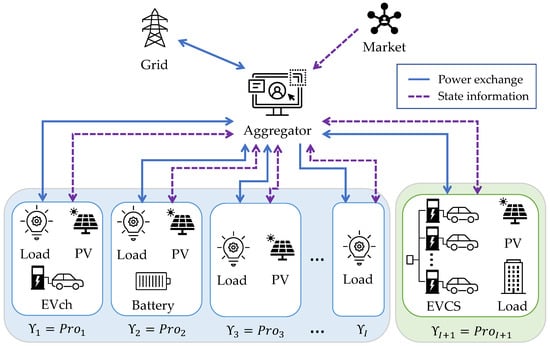
Figure 1.
General scheme between an Aggregator and different users-prosumers.
The users involved in the aggregator’s programs are prosumers or users that only consume energy. In this research, there are users, in which the majority are prosumers. In addition, these users are divided into two sub-groups as:
- I residential users;
- 1 commercial user.
The main characteristics and the formulations of these two sub-groups are presented in the following subsections.
2.1. Residential Prosumers
A typical residential prosumer, named in this research as , may contain a set of consumption and generation elements, as:
where refers to the i-th prosumer inflexible demand, such as lights or household appliances; refers to the RES generation installed at the i-th prosumer that could be PV or wind turbine technologies. For this research only PV is considered; means that in the i-th prosumer exists an energy consumption due to an EV charger working with smart charging (V1G) or not controlled strategies; and, means that the i-th prosumer has a battery storage system. Notice that, the EV chargers do not consider a bidirectional energy flow, i.e., there is no Vehicle-to-Grid (V2G) operation [28]. However, the battery storage system can behave as a consumer or as a generator, depending on the prosumer’s needs and the aggregator’s decision.
The elements able to provide electrical flexibility, i.e., the flexible loads related to these prosumers, are: (i) the EV chargers and (ii) the batteries. Moreover, not all prosumers have all the elements presented in the set of Equation (1). In fact, residential prosumers may have any combination of these elements (see Figure 1). Nevertheless, at least one consumption and one generation element must be present in the . Therefore, these users behave as prosumers, i.e., . Moreover, not only prosumers are considered to be managed by an aggregator but also users that only consume energy, i.e., users that only have the element. In this research, the diverse elements of prosumers and users depend on the actual user’s facilities, i.e., considering the information of real databases. Then, the elements presented in Equation (1) are defined by real users to be controlled by an aggregator.
In order to present the energy balance for a residential prosumer that considers all elements of the set in Equation (1), the model in Equation (2) is formulated. Nevertheless, for prosumers with different element combinations, the model is still the same but considering a null response in the unexisting element. This is also valid for the users that only have the element, i.e., users that are not prosumers.
This energy balance model contemplates in the grid power delivered to the i-th prosumer at the k-th time slot, and in the power delivered by the i-th prosumer to the grid at the k time slot; while the and are binary variables used for allowing the aggregator only one direction of the energy at each k time slot. Moreover, on the right side of the equality equation, the elements of the set in Equation (1) are considered as
- the power demanded by the in the variable ;
- the power demanded or delivered by the in the and variables, respectively;
- the power demanded by the prosumer in the variable; and,
- the power delivered by the in the variable.
In the following analysis, the and the variables are taken form historical data and are considered as parameters for the aggregator, whereas , , and are decision variables.
Regarding the EV charger dynamics, the model proposed in [29] is used. In fact, the SoC dynamics of the charger in the i-th prosumer are presented in Equation (3). It has a switching behaviour that depends on the binary variable , which exhibits if there is an EV connected or not. The model is characterised by transitions either from 0 to the arrival SoC () at the EV arrival time , or from the departure SoC () to 0, at the EV departure time .
where is the accumulated energy in the EV battery through the integration of the charging power . is the sampling time. It is worth noticing that this model is not for a single EV but for an EV charger, in which charge for several EVs during the day can occur. Moreover, this charger model requires as input the arrival and departure times of the EVs to be plugged in. Therefore, to develop a fair case, these connection times, i.e., the EVs schedule, are considered from real EV data based and are handled as a non-uncertain approach.
Moreover, the battery systems dynamics model is considered as presented in Equation (4), in which the energy stored evolves depending on the power that can be absorbed , or delivered at each k time slot. The absorbed energy can be acquired form the grid or the RES generation; likewise, the delivered power can be injected into the grid or the household consumption.
2.2. Commercial Prosumer
In this research, the commercial prosumer is considered as an Electric Vehicle Charging Station (EVCS) that contains a PV generation plant and a non-flexible demand, as presented in the of Figure 1.
In this prosumer, the flexibility is provided by the EV chargers of the EVCS. Then, the energy balance for the commercial prosumer is formulated in Equation (5) as,
where is the power demanded by the m-th EV charger at the k time slot, and are the non-flexible demand and the RES generation, respectively. Then, the power demanded by all EV chargers of the EVCS is,
The operation model of the EVCS is based on [30]. The model considers an initial scheduling phase and then an EV load profile management operation. This EVCS aims to charge all the connected EVs within their own charging time and achieving a departure SoC between the minimum SoC desired by the owners at the departure time and full charge (100%). The EV charger dynamics of the EVCS is modelled as the residential EV charger, i.e.,
where is the stored energy in the EV connected to the m-th EV charger at the k time slot, and is the arrival SoC of the j EV.
2.3. Aggregator
In this subsection, different aggregator strategies are proposed as well as a benchmark strategy. The aggregators look for defining the EV chargers and battery systems’ power profiles, based on different economic aims. Then, with the purpose of focusing in technical considerations, let us assume there are bilateral contracts between the aggregators and the users as well as between the aggregator and the system operator of the electrical grid. Moreover, the elements such as Load and PV are considered as parameters; then, the aggregator does not decide its patterns but decides on the flexible loads’ consumption patterns.
The four strategies assessed in this research are presented bellow.
2.3.1. Case 1. Benchmark
This is a standard approach based on a logic and sequential controller. It looks for charging the EVs of the residential prosumers and the EVs connected to the EVCS. This strategy charges the EVs with the maximum allowed power, i.e., and , for the residential and commercial prosumers, respectively, until the EV reaches its full capacity or . The EV chargers starts charging as soon as the EV is connected and stops charging when the full charge is achieved or when the EV is disconnected.
Regarding the storage system of the residential prosumers, the controller charges when there is PV generation, then the will depend on the PV production of the prosumer at the time slot k. In addition, if the battery is fully charged, the PV supplies the household appliances. The battery storage will deliver power at night when there is no radiation, this energy is used for charging the EVs or feeding the household appliances.
Notice that this strategy does not take into account the time-varying energy price, nor the possibility to modify energy consumption for reducing the operation costs.
2.3.2. Case 2. Prosumers Cost Minimisation
This case aims to reduce the prosumers bill payment. It follows an optimisation process where the cost function is considered as,
where is the energy price the user pays the aggregator for the energy consumed from the grid. The complete optimisation problem with its constraints is presented in Equation (11).
In this case, the aggregator follows the SEC logic, i.e., adopting a cooperative approach through the promotion of the use of renewable sources for sharing energy, and the intelligent management of energy flows in order to obtain benefits in terms of sustainability and safety [31]. Therefore, the aggregator acts as an intermediary agent who has little to none remuneration for its operation. Likewise, there is no remuneration for the prosumers.
2.3.3. Case 3. Prosumers Cost Minimisation with Remuneration
This case has the goal of reducing prosumers’ energy costs as well as providing remuneration to the prosumers able to inject energy into the grid. Then, the case solves the following optimisation cost function, in which the payment for grid energy is minimised and the prosumers’ remuneration is maximised.
where is the prosumers’ remuneration price for the energy injected into the electrical grid. This problem considers the constraints presented in Equation (11).
Moreover, as in Case 2, the aggregator strategy of this case follows again a communitary scheme, in which the aggregator has little to none remuneration for its energy management.
2.3.4. Case 4. Aggregator Profit Maximisation
The aim in this case is to maximise the aggregator profit, which is presented as the costs minus the revenues. The aggregator and prosumers’ remuneration are taken into account. Therefore, the strategy is considered with the following cost function.
where is the energy price the aggregator pays to the market, and is the energy price the market pays to the aggregator for the surplus. Notice that the two aggregator costs are the energy bought to the energy market and the prosumers’ remuneration, whereas the two aggregator revenues are the users’ energy payment and the remuneration for the energy injected into the grid. The constraints of this problem are presented in Equation (11).
Therefore, the optimisation problem presented in Equation (11) is followed by cases 2, 3, and 4. This problem provides the solution of the residential system battery and EV charging powers , , and , at every time slot k, in each user i. Likewise, the problem offers the solution of the EV charging powers of the EVCS, at every time slot k, at each EV charger m.
Regarding the optimisation problem constraints, the EV charging dynamics in the residential prosumers’ and in the EVCS as well as the battery system dynamics are considered in Equation (11b). The residential and commercial energy balances are presented in the constraint Equation (11c). Constraints Equation (11d) and Equation (11e) provide the minimum SoC at the departure ( or ) of the i-th or j-th EV connected to a house or the charging station, this value is desired by the EV owner. Likewise, these constraints consider the EVs full charge value, i.e., or . Constraint Equation (11f) limits the maximum power that the EVCS can deliver to the hole EV chargers at the time slot k. The decision variables bounds are taken into account in Equation (11g), Equation (11h), and Equation (11i). The bounds of the EV batteries and battery storage systems are presented in Equation (11j), Equation (11k), and Equation (11l), in which and are 100% of the EV battery SoC; while the limits of are usually different from 0 and 100% for battery lifespan purposes. The output variables are positive as presented in Equation (11m). Constraints in Equation (11n), Equation (11o), and Equation (11p) are used for defining the initial value of the state variables. The last constraint, i.e., Equation (11q), is used for allowing only one energy flow direction at time slot k at the user i.
To sum up, the aggregator has no profit in cases 1, 2, and 3. In fact, Case 1 has no aggregator, i.e., there is no energy management, only a user controller is considered. In addition, in cases 2 and 3, the aggregator is managing the prosumers’ energy but there is no benefit for this agent due to the energy share in the SEC perspective. On the contrary, Case 4 is the only case in which the aggregator has a remuneration and looks to maximise its profit. The aggregators in the last three cases face a linear programming problem.
These cases are useful to evaluate and compare different scenarios starting from a current situation in which no optimisation is performed, and moving through smart strategies that consider prosumers’ remuneration and aggregator profit.
3. Case Study
In this section, a case study with several simulation results is presented. The aim is to assess the four cases considering real consumption and generation data.
3.1. Data-Sets
In order to evaluate the aggregation strategies, four different data-based are used:
- Pecan Street Dataport [32], it is used for defining the Load and PV elements of all the residential users. In addition, the arrival and departure times of the residential EVs are detected.
- ACN-Data [33], which provides information for the EVCS operation. The considered data for each EV charger is the arrival and departure time, the energy capacity requested by the EV owner, and the actual delivered energy.
- Renewables Ninja [34]. Data from this platform is generated for defining the PV element on the commercial prosumer.
- Entso-e Transparency Platform [35]. Energy prices from the Italian market are acquired with this data-based and used by the aggregators strategies.
Moreover, in the commercial prosumer, the Load element is generated considering classic profiles [36].
In this research, 50 users of the 73 available in the Pecan Street Dataport are selected, considering the users with less outliers. This data reports the measurements in a 15 min sample time. Regarding the EV chargers information reported, it is noticed that the EV chargers have a V1G charge due to the charging periods. Therefore, we preprocess the connection time periods based on the reported charging periods and typical residential usage patterns [37], e.g., when the EV chargers report a charging event from 3:30 to 5:00 in almost every connection period (several days), the connection periods are modified for hours before 24:00 and the disconnection periods for hours after 5:00. These connection and disconnection hours are selected with uniform distributions. Then, the Probability Distribution Function (PDF) of the arrival and departure time instants in a day is depicted in Figure 2a. It can be seen that the majority of EVs are connected between 16:00 and 20:00. The EV departure distribution has two-time instants in which EVs are more frequent, between 6:00 to 10:00 and 17:00 to 20:00. Likewise, the arrival and departure time PDFs of the ACN-Data are reported in Figure 2b. The figure presents how the majority of EVs arrive around 16:00, whereas the departure occurs at around midnight. These data are considered in their original time zones, i.e., for Pecan Street Dataport in Texas, USA, is GMT-5; while for ACN-Data in California, USA, is GMT-7.
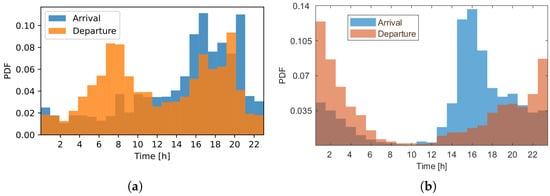
Figure 2.
EV connection time information. (a) Pecan Street Dataport. (b) ACN-Data.
In addition, we propose to add a non present element in the Pecan Street Dataport, i.e., the battery storage systems. This element not only allows a more comprehensive case study and evaluation but also adds flexibility to the users.
In order to understand the elements that each residential user has, refer to Figure 3. The length reported in each element refers to the maximum reported power in the database for a single sample time. Regarding the battery systems, the maximum power is assumed equal to the maximum EV charging power.
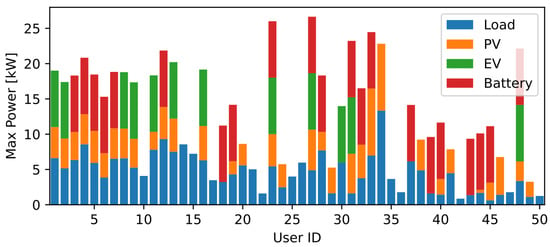
Figure 3.
Elements in the 50 residential users (maximum reported power).
In the commercial prosumer, the data for the EVCS is taken from the ACN-Data repository. This data, instead of reporting information in each time step (as in the Pecan Street Data), it reports the significant data at the event time. The information is used to schedule the EVCS chargers’ occupancy.
3.2. Scenario Setup
In this subsection, preliminary simulation results are presented with the purpose of assessing the behaviour of the users in all the aggregation cases. Likewise, the payments made by the residential and commercial users are evaluated. The simulation horizon is a working week with a sample time of 15 min. The simulations are performed in the open-source cross-platform integrated development environment Spyder, written in Python language. Whereas, the optimisation problem solutions are obtained with the Gurobi solver.
The assessed scenario is developed with residential Pecan Street users with the elements present in Figure 3.
Regarding the data-sets described in the previous subsection and the simulated horizon, there are 86 and 204 EV charging events in the residential users and in the EVCS chargers, respectively. The EVCS has EV chargers. In addition, the data-set is also used for computing the minimum EV SoC at the departure of each EV at the EVCS, it is considered as the initial SoC plus the energy requested by the EV owner. While the minimum EV SoC at the departure of each residential EV is defined as: (i) full charge (100%) when there is enough time to charge it, or (ii) the maximum possible SoC achieved at the connected period by injecting 80% of the maximum power.
In the simulations, it is assumed that the residential EV chargers’ power are level 2 with a kW, while the EV chargers’ power at the EVCS are level 3 with a kW. The EV battery capacities are taken as kWh for all EVs. The EV arrival SoCs ( and ) of all EVs are generated with a uniform distribution between the 10% and 25% of the EV battery capacities.
Two electric energy price sequences are used (see Figure 4) for evaluating the aggregators response. These prices are selected due to their nature, seen one as an hourly time-variant (Price 1) and the other one as a time-of-use (Price 2).

Figure 4.
Hourly electrical energy price sequences 1 and 2.
3.3. Prosumers Analysis
This subsection presents how the aggregated prosumers respond in the different cases and the payment variations between the cases.
Considering the scenario setup presented previously, a simulation campaign is developed using Price 1 as the energy price the aggregator pays to the market, i.e., the price (Price 2 is not considered). Other prices and remuneration are assumed as: , , and .
The simulation results of residential and commercial users aggregation is presented in Figure 5. In particular, Figure 5a,c depict the aggregator inputs, i.e., the Load and PV elements. Notice that the load or demand power is the same for all cases fixing the peak hours every day at night with similar power magnitudes. Likewise, the PV element or RES generation is not changing between the cases, and as expected the peak hours are around midday with different peak power magnitudes.
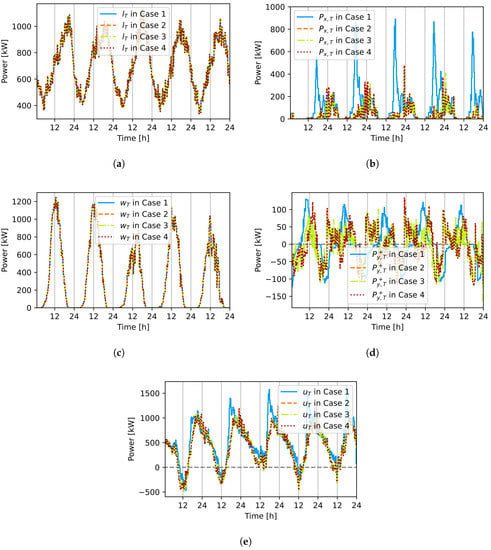
Figure 5.
Total aggregator inputs, decision variables, and outputs. (a) Load demand (input). (b) EV power demand (decision variable). (c) PV generation (input). (d) Battery power exchange (decision variable). (e) Grid power exchange (output).
Moreover, the aggregation of the decision variables are presented in Figure 5b,d, i.e., the EVch and Battery elements, respectively. It can be seen that Case 1 has the highest power peaks in the EV power demand due to the uncoordinated charging; while the other cases charge with similar profiles between them. In addition, the battery systems power exchange of Case 1 shows that when there is sun, the batteries only increase their storage with different power levels, whereas at night, the batteries use the energy for feeding the user loads. In addition, in the other three cases, the battery consumes or injects power depending on the aggregator’s objective. In particular, Case 3 has high variability due to the user’s remuneration when injecting power into the grid.
The grid power output variable is presented in Figure 5e where the power exchange between the aggregator and the electrical grid can be noticed. It can be seen that four days are injecting an important amount of power into the grid. Due to the low PV production on the third day, no power injection in Case 1 and lower injection in the other cases are presented. Notice that the higher power demands are presented for Case 1, while the highest negative peaks, i.e., highest power injections are given by Case 3.
Table 2 is presented with the purpose of analysing the total payment of the residential users and the commercial EVCS. Likewise, this table presents the percentage reduction of each case in comparison with Case 1. Regarding the residential users, the lowest payment is presented in Case 3 with a reduction of 8.9% which is not so different from Case 4 with 8.8%. The commercial EV station has a payment reduction of 48.2% with any case. This reduction is the same between the cases given that there is not enough PV production to inject into the grid leading to no remuneration for the station. Then, the suitable aggregator for the users in this price configuration is Case 3. It is worth noticing that the payment reduction is due to the EV chargers and battery storage smart management.

Table 2.
Users payments by each case and the reduction percentage with respect to Case 1.
Therefore, we can conclude that for the residential users it is beneficial to be involved in the aggregator scheme of Case 3 or 4. However, not all users have the same configuration; then, it is important to understand if all users will have the same payment reduction and also how dependant are from the energy prices and remuneration prices, which is presented next.
4. Sensitivity Analysis
In the previous section, the aggregated users response have been presented considering a set of energy and remuneration prices. However, this section looks for studying how dependant is billing to the energy and remuneration prices. Therefore, a sensitivity analysis is carried out to identify the price impact for users, prosumers and aggregators. Likewise, the feasibility for the single user to be involved in aggregator strategies is evaluated.
The energy and remuneration price sensitivity analysis consider the market price as fixed, leading to different price variations in , , and . Therefore, for the sake of simplicity, these price variations are considered as combinations of the market price as,
Then, the parameters , , and are varied as presented in Table 3.

Table 3.
Parameters in each scenario for the sensitivity analysis.
From Table 3, it is noticed that there are 26 scenarios () per price. Then, when considering the two energy price sequences presented in Figure 4, the total number of scenarios is 52, in which the parameters from scenario 27 to 52 are the same as from 1 to 26. In other words, Price 1 is applied in scenarios from 1 to 26, and Price 2 in scenarios from 27 to 52.
4.1. Residential Users Evaluation
This subsection aims to analyse the residential users payment at each case in the simulation horizon. In this analysis, only Price 1 is taken into account, i.e., scenarios from 1 to 26.
The distribution of the users payment at each case is presented in Figure 6. A user payment reduction can be noticed from Case 1 (see Figure 6a) to Case 2 (see Figure 6b), in which the users distribution are higher for the initial 20 users and lower for the last users, being less sensible to the price and remuneration variations. Moreover, the users distributions in Case 3 (see Figure 6c) and Case 4 (see Figure 6d) are higher than for cases 1 and 2. In particular, some users ID between numbers 23 and 46 can receive a payment instead of paying to the aggregator (see payments distributions under zero), e.g., users ID 40 and 45 receive a payment remuneration from the aggregator instead of paying a bill. Notice that this payment is possible for any price and remuneration combination. As presented in Figure 3, User ID 40 and 45 are prosumers with a low power demand that have PV generation and battery systems.
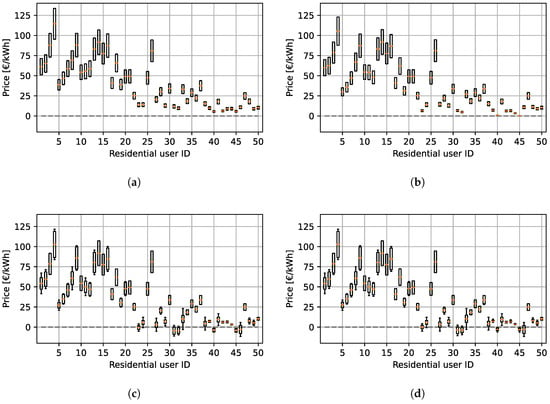
Figure 6.
Residential users payment distribution in each case, considering Price 1. (a) Case 1. (b) Case 2. (c) Case 3. (d) Case 4.
An important measurement to consider is the dispersion of user payments across different scenarios. For this aim and being aware of the previous results, Figure 7 presents the variance of each user at each case, in which is possible to understand how sensitive are the users to the price variations. It can be seen that users as 4, 14, 15, and 26 are highly affected by the prices. These users have only the Load element (see Figure 3), while user 4 also has the PV and Battery elements. In the other hand, users ID as 42, 43, 44, and 45 remain almost with same payment when varying the prices. These users consider more diverse elements, e.g., users 44 and 45 have Load, PV and Battery elements, user 43 has Load and Battery, while 42 has only Load.
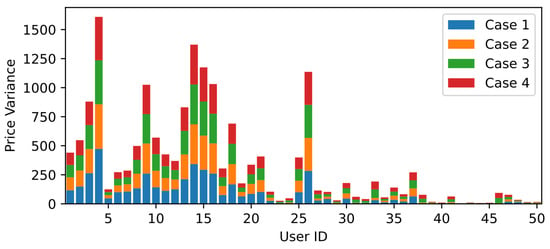
Figure 7.
Users price variance.
Therefore, it is not possible to conclude about a configuration that follows a similar response. However, a trend in the Load element is observed, in which users that have more power demand in the Load element, achieve higher price variances. While users that have low power demand, achieve lower price variations.
Cases 2 and 3 do not consider aggregator profit; likewise, Case 1 has no aggregator; and, only Case 4 considers it. In Figure 8 the aggregator profit perceived from each user is presented. The negative prices are the payments that the aggregator receives for managing the energy of each user. It is worth noticing that all the mean values are lower than zero. Therefore, for the aggregator is profitable to manage all the residential users.
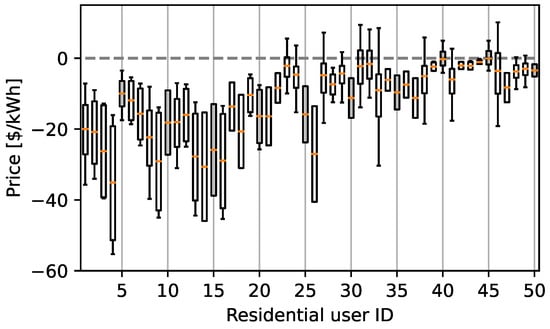
Figure 8.
Aggregator profit by each user in Case 4 considering Price 1.
The aggregator must carefully accept the price combination to avoid reducing its profit with the users’ remuneration payment. For instance, User ID 40 and 45 have a distribution between positive and negative values, being counterproductive the positive values in the aggregator. Nevertheless, not only users 40 and 45 have positive values; therefore, in an aggregator perspective, only scenarios with negative prices (see Figure 8) are profitable.
In order to assess the aggregator profit by considering users distribution in each scenarios, Figure 9 is depicted. Notice that Price 1 and Price 2 are evaluated. A similar performance is noticed between the two prices, i.e., between the scenarios 1 to 26 and 27 to 52. A higher payment (negative prices) is expected to be noticed for the scenarios where is the highest one, i.e., from 18 to 26 with Price 1 and from 44 to 52 with Price 2, meaning that the users pay more for the grid energy. In addition, scenario such as 2, 5, 10, 11, 14, 19, 20, 23, 28, 31, 36, 37, 40, 45, 46, and 49 are not desired scenarios for the aggregator due to a profit reduction given by users that are receiving a higher remuneration. These scenarios are characterised by higher than , i.e., the users price remuneration is higher than the aggregator remuneration (see Table 3).
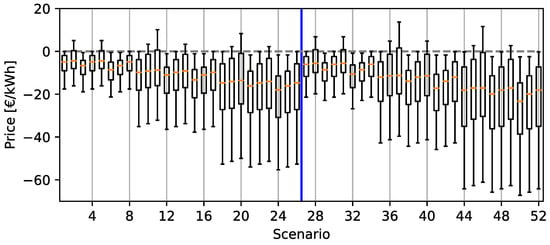
Figure 9.
Aggregator profit by each scenario in Case 4.
4.2. Cases Comparison
This subsection aims to assess which of the strategy or case is the most beneficial for residential and commercial users. Therefore, Figure 10 compares the total payment at each case for each type of user. It can be seen that for the residential users (see Figure 10a) cases 3 and 4 have the lowest payments, being the case 3 the lowest payment. Hence, the Case 3 in general is the best strategy for the residential users. However, the Case 4 is also a suitable solution for these users.
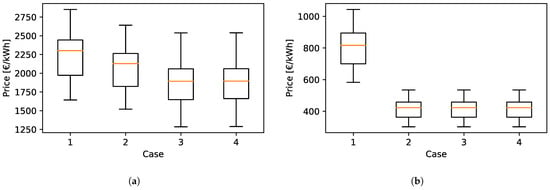
Figure 10.
Cases price variation for residential and commercial users, considering all the scenarios. (a) Residential. (b) Commercial (EVCS).
Regarding the commercial user (see Figure 10b), i.e., the EVCS, cases 2, 3 and 4 have quite similar response due to its high demand. Moreover, the RES production is not enough for injecting energy into the electrical grid and receive a payment remuneration. In the figure, the distribution of cases 2, 3, and 4 are smaller than in case 1, leading the commercial user to be less dependant on the prices and remuneration values. Hence, for the commercial user it is useful to be involved in any of the cases 2, 3, or 4.
4.3. Suitable Strategy for Prosumers
This subsection looks for analysing the single user response to different scenarios.
First, a clustering method is used to partition the users into different clusters depending on the payment variation in the 52 analysed scenarios in the four cases, for a total of 208 scenarios. The aim is to understand how users with different element combinations and power demands can be clustered depending on how sensible are they to the price variations, as well as to provide a guideline of the payment options for future users’ to be involved in aggregator schemes.
Second, a comparison between Case 1 and Case 4, i.e., the standard or current approach and the aggregator maximisation profit is developed with the aim of defining how suitable is for each user to be involved in the aggregator management of Case 4. The Case 4 is selected for the comparison because it is the most applicable in the near future considering the energy market trend.
4.3.1. Clustering Users by the Payment Variations
The clustering process is developed considering the 50 residential users, while the commercial user is assigned to a single cluster due to its highest payments around the scenarios.
The classification is performed with the K-means clustering method, using the squared Euclidean distance metric. The optimal number of clusters is evaluated with the silhouette criterion in which the silhouette value for each point is a measure of how similar that point is to other points in the same cluster, compared to points in other clusters. The evaluation is performed considering a maximum of 7 groups. Figure 11 present the silhouette values for the evaluated groups achieving a maximum value of 0.793 for 4 clusters, meaning that the optimal number of clusters is 4. The K-means algorithm uses a heuristic to find the centroid location of each cluster.
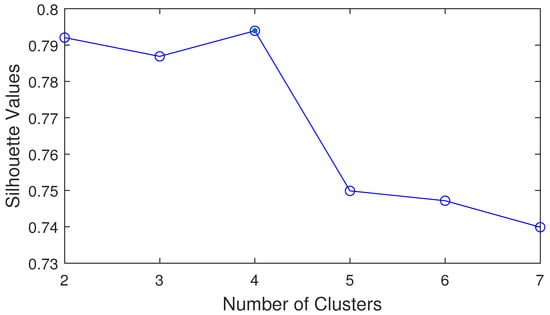
Figure 11.
Silhouette value evaluation for the clusters.
Figure 12 presents the clusters. However, Figure 12a depicts the silhouette from the clustered data using the euclidean distance metric, presenting how the data are split into the 4 clusters. The other sub-figures present the clusters with the users’ payments in each scenario. Notice that each cluster presents the centroid location with black circular markers. Cluster 1 is presented in Figure 12b; it can be seen that the variations between the case profiles are similar, cases 3 and 4 present more ripple for specific users. Figure 12c shows Cluster 2 which has significant variations between cases; indeed, cases 3 and 4 achieve negative values for some scenarios, i.e., the users will receive a payment instead of paying a bill. In Figure 12d, Cluster 3 is presented; regardless of user ID 33, all payments are positive and decrease between the case profiles. The payments profile of User ID 33 in cases 3 and 4 move away from the centroid giving a negative silhouette (see Figure 12a). Figure 12e shows Cluster 4 which is similar to Cluster 1 but with higher payments. The commercial user payments profile is assigned to the Cluster 5 presented in Figure 12f. This cluster is not considered in the K-means process.
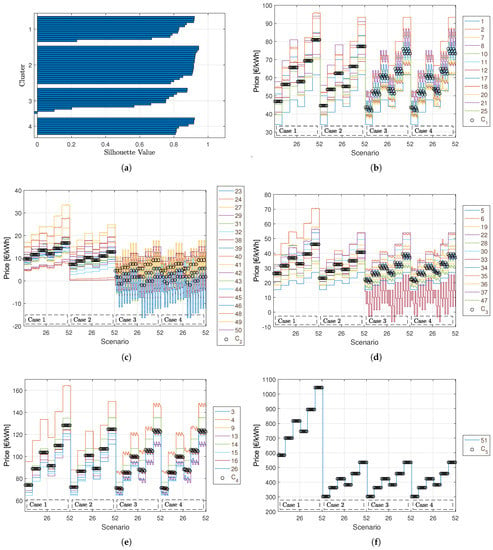
Figure 12.
Clusters. (a) Silhouette from the clustered data. (b) Cluster 1. (c) Cluster 2. (d) Cluster 3. (e) Cluster 4. (f) Cluster 5. Not considered in the clustering method.
Table 4 presents all the users elements combinations and how they are divided in the different clusters. Then, the users with only the Load element are located in all the clusters; however, the power demanded by these users is different between them. In fact, these users of Cluster 2 have a low power demand, contrary from Cluster 4, in which the highest power demands are located, while clusters 1 and 3 have a medium demand. The prosumers with the combination of Load and PV are mostly located in Cluster 2, giving important revenues to these users when injecting power into the grid in cases 3 and 4. The prosumer ID 30 with Load and EVch is located at Cluster 3. Prosumers with Load and Battery elements are divided into clusters 1, 2, and 3; nevertheless, half of them are in Cluster 2. Regarding the prosumers with Load, PV, and EVch elements, they are divided into clusters 1 and 4, this due to the Load element that demands an important amount of power. The prosumers with the combination of Load, PV, and Battery are split into all the clusters; however, the users largest parts are located in clusters 2 and 3, which provides the lowest payments. Finally, the users with all elements are located in the cluster 2.

Table 4.
Number of users involved at each cluster with their elements combination. In brackets the User ID is reported.
Therefore, the cluster with the majority of the users and higher diversity is Cluster 2; in fact, it is the most attractive one for users due to their payment remunerations. However, it is important to highlight that these users usually have low inflexible power demand or high PV generation.
4.3.2. Current and Near Future Strategies Comparison
The comparison between Case 1 and Case 4 aims to define for each user if is suitable or not to be involved in the aggregator strategy. Therefore, the difference in percentage between both cases is developed considering all the scenarios.
In Figure 13 the difference between the strategies is presented. In fact, Figure 13b is a zoom of Figure 13a in which is possible to understand for each user if is suitable or not to participate in the aggregation strategy. In the figure, the distribution of each user refers to the several scenarios differences and the values are explained as follows.
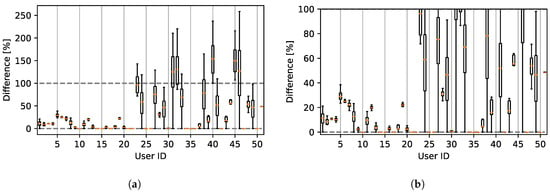
Figure 13.
Price comparison, difference between Case 1 and Case 4. (a) Complete. (b) Zoom.
- Difference ≈ 0%: It means that the difference in the payment made by the user in Case 1 and Case 4 is negligible, i.e., the user will pay almost the same value. The users in this situation are: 10, 14, 15, 17, 21, 22, 25, 26, 34–36, 42, 47, and 50. Notice that these users correspond to the 13 users with only the Load element plus the user ID 34 (user with PV generation).
- 0% < Difference < 100%: It means that there is a reduction in the bill payment of the percentage shown in the figure. Considering the mean vale of the distribution, the users ID in this payment reduction are: 1–9, 11–13, 16, 18–20, 23, 24, 27–30, 33, 37, 38, 39, 41, 43, 44, 48, 49, and 51.
- Difference > 100%: It means that these prosumers instead of paying a bill will receive a payment. Considering the mean vale of the distribution, the users ID that receive a payment are: 31, 32, 40, 45, and 46. However, for those users, this payment will depend on the evaluated scenario. Notice that all of them are in Cluster 2 (see Figure 12c).
- Difference < 0%: It means that the users pay more in Case 4 than in Case 1. There is no user in this situation.
Moreover, users ID 23, 24, 27, 31–33, 38, 41, and 46 can achieve a payment reduction or receive a payment depending on the scenario. All these users except user 33 are classified in Cluster 2. Regarding user 33, it belongs to Cluster 3 but with a negative silhouette, understanding that this user is not properly classified. In addition, it is important to see that users ID 40 and 45 (Cluster 2) always will receive a payment.
5. Conclusions
Remuneration schemes for prosumers and aggregators have been proposed and compared with a standard approach, named Case 1. The aggregation schemes have different aims as, Case 2 looks for minimising users bill without aggregation profit; Case 3 is as Case 2 but considering users remuneration; and Case 4 which aims to maximise the aggregator profit. The comparison of the strategies consider different energy and remuneration prices, leading to simulate how profitable the strategy is for prosumers and aggregators.
The mathematical formulation of residential and commercial prosumers is presented considering electric vehicle chargers and battery storage systems as flexible loads. The other elements assessed in the prosumers are renewable energy sources and non-flexible demand. It is not possible to conclude about a configuration that follows similar variance responses. However, a trend in the Load element is observed, in which users that have more power demand in the Load element, achieve higher price variances. While users that have low power demand, achieve lower price variations.
The case study provides a guidance for prosumers with different configurations on how profitable it is to be involved in aggregation strategies. For instance, for the residential users it is beneficial to be involved in the aggregator scheme of Case 3 or 4; while for the commercial user any case different from the standard approach is profitable, this will depend on the RES production.
The simulation results show that there is no single case that improves all users’ payments. However, there is a trend as, Case 1 used to be the most expensive, while Case 3 was the most economical because of the cost minimisation and energy remuneration. Case 4, which seems to be the most likely scenario to be implemented in the short term, has lower costs than the benchmark and also provides economic benefits to the aggregator. Therefore, if a user wants to be involved in an aggregator structure, it must be aware of the aggregation aim, because this can positively or negatively impact its costs.
The aggregation strategies presented in this paper consider historical data on renewable energy, household demand, as well as electric vehicle arrival and departure times. Future work will evaluate the strategies considering end-user uncertainties not only in the consumption, generation, and energy prices but also in the electric vehicle connection periods. Moreover, a new strategy considering vehicle-to-grid will be assessed in the remuneration sensitivity analysis.
Author Contributions
Conceptualisation C.D.-L. and C.A.C.-F.; Data curation C.D.-L.; Formal analysis C.D.-L., J.V. and C.A.C.-F.; Funding acquisition C.A.C.-F.; Investigation C.D.-L. and C.A.C.-F.; Methodology C.D.-L., J.V., G.G. and C.A.C.-F.; Software C.D.-L.; Supervision C.A.C.-F.; Validation C.D.-L., J.V., G.G. and C.A.C.-F.; Visualisation C.D.-L.; Writing-original draft preparation C.D.-L., J.V., G.G. and C.A.C.-F. All authors have read and agreed to the published version of the manuscript.
Funding
This research was funded by Pontificia Universidad Javeriana through the research project titled “Remuneración y operación óptima de esquemas agregador-prosumidor en sistemas de energía”, identified with ID 20271.
Institutional Review Board Statement
Not applicable.
Informed Consent Statement
Not applicable.
Data Availability Statement
Not applicable.
Conflicts of Interest
The authors declare no conflict of interest.
Abbreviations
The following abbreviations are used in this manuscript:
| EV | Electric Vehicle |
| EVCS | Electric Vehicle Charging Station |
| DR | Demand Response |
| DSM | Demand Side Management |
| DSO | Distribution System Operator |
| PV | Photo-Voltaic |
| RES | Renewable Energy Sources |
| SEC | Smart Energy Community |
| SoC | State of Charge |
| ToU | Time-of-Use |
| V1G | Smart Charging |
| V2G | Vehicle-to-Grid |
| V2X | Vehicle-to-everything |
| VPP | Virtual Power Players |
References
- Teske, S. Achieving the Paris Climate Agreement Goals; Springer Nature: Berlin, Germany, 2019. [Google Scholar]
- Manuel de Villena, M.; Gautier, A.; Ernst, D.; Glavic, M.; Fonteneau, R. Modelling and assessing the impact of the DSO remuneration strategy on its interaction with electricity users. Int. J. Electr. Power Energy Syst. 2021, 126, 106585. [Google Scholar] [CrossRef]
- Vuelvas, J.; Ruiz, F.; Gruosso, G. Limiting gaming opportunities on incentive-based demand response programs. Appl. Energy 2018, 225, 668–681. [Google Scholar] [CrossRef]
- Vuelvas, J.; Ruiz, F. Rational consumer decisions in a peak time rebate program. Electr. Power Syst. Res. 2017, 143, 533–543. [Google Scholar] [CrossRef]
- Lu, L.; Price, C. Designing Distribution Network Tariffs That Are Fair for Different Consumer Groups; Technical Report; Centre for Competition Policy, University of East Anglia: Norwich, UK, 2018. [Google Scholar]
- Venizelou, V.; Philippou, N.; Hadjipanayi, M.; Makrides, G.; Efthymiou, V.; Georghiou, G.E. Development of a novel time-of-use tariff algorithm for residential prosumer price-based demand side management. Energy 2018, 142, 633–646. [Google Scholar] [CrossRef]
- Faria, P.; Spínola, J.; Vale, Z. Methods for Aggregation and Remuneration of Distributed Energy Resources. Appl. Sci. 2018, 8, 1283. [Google Scholar] [CrossRef]
- Di Silvestre, M.L.; Gallo, P.; Sanseverino, E.R.; Sciumè, G.; Zizzo, G. Aggregation and Remuneration in Demand Response With a Blockchain-Based Framework. IEEE Trans. Ind. Appl. 2020, 56, 4248–4257. [Google Scholar] [CrossRef]
- Silva, C.; Faria, P.; Vale, Z. Multi-Period Observation Clustering for Tariff Definition in a Weekly Basis Remuneration of Demand Response. Energies 2019, 12, 1248. [Google Scholar] [CrossRef]
- Silva, C.; Faria, P.; Vale, Z. Combining real-time and fixed tariffs in the demand response aggregation and remuneration. Energy Rep. 2020, 6, 114–119. [Google Scholar] [CrossRef]
- Gržanić, M.; Capuder, T.; Zhang, N.; Huang, W. Prosumers as active market participants: A systematic review of evolution of opportunities, models and challenges. Renew. Sustain. Energy Rev. 2022, 154, 111859. [Google Scholar] [CrossRef]
- Evangelopoulos, V.A.; Kontopoulos, T.P.; Georgilakis, P.S. Heterogeneous aggregators competing in a local flexibility market for active distribution system management: A bi-level programming approach. Int. J. Electr. Power Energy Syst. 2022, 136, 107639. [Google Scholar] [CrossRef]
- Ribeiro, C.; Pinto, T.; Vale, Z.; Baptista, J. Dynamic remuneration of electricity consumers flexibility. Energy Rep. 2022, 8, 623–627. [Google Scholar] [CrossRef]
- Arnone, D.; Cacioppo, M.; Ippolito, M.G.; Mammina, M.; Mineo, L.; Musca, R.; Zizzo, G. A Methodology for Exploiting Smart Prosumers; Flexibility in a Bottom-Up Aggregation Process. Appl. Sci. 2022, 12, 430. [Google Scholar] [CrossRef]
- Ramos, A.; De Jonghe, C.; Gómez, V.; Belmans, R. Realizing the smart grid’s potential: Defining local markets for flexibility. Util. Policy 2016, 40, 26–35. [Google Scholar] [CrossRef]
- Iazzolino, G.; Sorrentino, N.; Menniti, D.; Pinnarelli, A.; De Carolis, M.; Mendicino, L. Energy communities and key features emerged from business models review. Energy Policy 2022, 165, 112929. [Google Scholar] [CrossRef]
- Wu, Y.; Wu, Y.; Cimen, H.; Vasquez, J.C.; Guerrero, J.M. Towards collective energy Community: Potential roles of microgrid and blockchain to go beyond P2P energy trading. Appl. Energy 2022, 314, 119003. [Google Scholar] [CrossRef]
- Diaz-Londono, C.; Colangelo, L.; Ruiz, F.; Patino, D.; Novara, C.; Chicco, G. Optimal Strategy to Exploit the Flexibility of an Electric Vehicle Charging Station. Energies 2019, 12, 3834. [Google Scholar] [CrossRef]
- Almeida, J.; Soares, J.; Canizes, B.; Vale, Z. Coordination strategies in distribution network considering multiple aggregators and high penetration of electric vehicles. Procedia Comput. Sci. 2021, 186, 698–705. [Google Scholar] [CrossRef]
- Shojaabadi, S.; Talavat, V.; Galvani, S. A game theory-based price bidding strategy for electric vehicle aggregators in the presence of wind power producers. Renew. Energy 2022, 193, 407–417. [Google Scholar] [CrossRef]
- Guzman, C.P.; Romero, R.; Arias, N.B.; Rider, M.J.; Franco, J.F. Secondary Reserve Provision through a Smart Aggregation Strategy of Electric Vehicles. In Proceedings of the 2021 IEEE Madrid PowerTech, Madrid, Spain, 28 June–2 July 2021; pp. 1–6. [Google Scholar] [CrossRef]
- Islam, S.; Iqbal, A.; Marzband, M.; Khan, I.; Al-Wahedi, A.M. State-of-the-art vehicle-to-everything mode of operation of electric vehicles and its future perspectives. Renew. Sustain. Energy Rev. 2022, 166, 112574. [Google Scholar] [CrossRef]
- Diaz-Londono, C.; Correa-Florez, C.A.; Vuelvas, J.; Mazza, A.; Ruiz, F.; Chicco, G. Coordination of specialised energy aggregators for balancing service provision. Sustain. Energy Grids Netw. 2022, 32, 100817. [Google Scholar] [CrossRef]
- Vuelvas, J.; Ruiz, F.; Gruosso, G. A time-of-use pricing strategy for managing electric vehicle clusters. Sustain. Energy Grids Netw. 2021, 25, 100411. [Google Scholar] [CrossRef]
- Badami, M.; Fambri, G.; Mancò, S.; Martino, M.; Damousis, I.G.; Agtzidis, D.; Tzovaras, D. A Decision Support System Tool to Manage the Flexibility in Renewable Energy-Based Power Systems. Energies 2020, 13, 153. [Google Scholar] [CrossRef]
- Dilger, M.G.; Konter, M.; Voigt, K.I. Introducing a co-operative-specific business model: The poles of profit and community and their impact on organizational models of energy co-operatives. J. Co-Oper. Organ. Manag. 2017, 5, 28–38. [Google Scholar] [CrossRef]
- Cohen, J.J.; Azarova, V.; Kollmann, A.; Reichl, J. Preferences for community renewable energy investments in Europe. Energy Econ. 2021, 100, 105386. [Google Scholar] [CrossRef]
- Giordano, F.; Ciocia, A.; Leo, P.D.; Mazza, A.; Spertino, F.; Tenconi, A.; Vaschetto, S. Vehicle-to-Home Usage Scenarios for Self-Consumption Improvement of a Residential Prosumer With Photovoltaic Roof. IEEE Trans. Ind. Appl. 2020, 56, 2945–2956. [Google Scholar] [CrossRef]
- Diaz, C.; Ruiz, F.; Patino, D. Smart Charge of an Electric Vehicles Station: A Model Predictive Control Approach. In Proceedings of the 2018 IEEE Conference on Control Technology and Applications (CCTA), Copenhagen, Denmark, 21–24 August 2018; pp. 54–59. [Google Scholar] [CrossRef]
- Diaz-Londono, C.; Ruiz, F.; Mazza, A.; Chicco, G. Optimal Operation Strategy for Electric Vehicles Charging Stations with Renewable Energy Integration. IFAC-PapersOnLine 2020, 53, 12739–12744. [Google Scholar] [CrossRef]
- Ceglia, F.; Esposito, P.; Marrasso, E.; Sasso, M. From smart energy community to smart energy municipalities: Literature review, agendas and pathways. J. Clean. Prod. 2020, 254, 120118. [Google Scholar] [CrossRef]
- Pecan Street Dataset. Dataport. Available online: https://www.pecanstreet.org/dataport/ (accessed on 10 October 2021).
- Lee, Z.J.; Li, T.; Low, S.H. ACN-Data: Analysis and Applications of an Open EV Charging Dataset. In Proceedings of the Tenth ACM International Conference on Future Energy Systems, Phoenix, AZ, USA, 25–28 June 2019; pp. 139–149. [Google Scholar] [CrossRef]
- Renewables Ninja. Available online: https://www.renewables.ninja/ (accessed on 10 October 2021).
- ENTSO-E Transparency Platform. Available online: https://transparency.entsoe.eu/ (accessed on 10 October 2021).
- Jardini, J.; Tahan, C.; Gouvea, M.; Ahn, S.; Figueiredo, F. Daily load profiles for residential, commercial and industrial low voltage consumers. IEEE Trans. Power Deliv. 2000, 15, 375–380. [Google Scholar] [CrossRef]
- Flammini, M.G.; Prettico, G.; Julea, A.; Fulli, G.; Mazza, A.; Chicco, G. Statistical characterisation of the real transaction data gathered from electric vehicle charging stations. Electr. Power Syst. Res. 2019, 166, 136–150. [Google Scholar] [CrossRef]
Publisher’s Note: MDPI stays neutral with regard to jurisdictional claims in published maps and institutional affiliations. |
© 2022 by the authors. Licensee MDPI, Basel, Switzerland. This article is an open access article distributed under the terms and conditions of the Creative Commons Attribution (CC BY) license (https://creativecommons.org/licenses/by/4.0/).